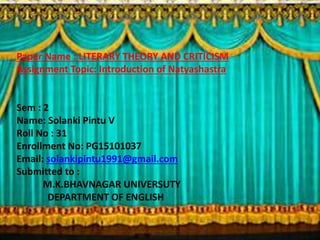
Inroduction to Natyashastra
- 1. Paper Name : LITERARY THEORY AND CRITICISM Presentation Topic: Introduction of Natyashastra Sem : 2 Name: Solanki Pintu V Roll No : 31 Enrollment No: PG15101037 Email: solankipintu1991@gmail.com Submitted to : M.K.BHAVNAGAR UNIVERSUTY DEPARTMENT OF ENGLISH
- 2. How Natyashastra came into existence Natya, the art of theatre (including dance), was the work of God Brahma, the creator, who was asked to give mankind a fifth Veda, which, unlike the four earlier Vedas, could be understood by everyone, even those who did not know Sanskrit. Thus Brahma created the Natya Veda, with the assistance of other gods.
- 3. Bharata and his Natyashastra Natya was then taught by God Brahma to the mythic sage Bharata, who is said to have recorded this teaching in the Natyashastra. The origin of the book is thus shrouded in mythology, but the work itself is indeed living reality. The Natyashastra is probably the world’s largest and most comprehensive theatre and dance manual, and it still forms the foundation of the classical forms of theatre and dance in India.
- 4. Natyashastra’s 36 chapters give instructions on almost all aspects of theatre and dance: The theatre building, The stage, The theory of poetry, The use of the voice, Make-up, Costume, Acting styles, Dance techniques, and even theatre criticism.
- 5. The Natyashastra introduced the theory of bhava and rasa, so central to Indian aesthetics. It had a profound effect on most of the traditional art forms of India. Bhava means an emotional state or mood, portrayed by the dancer-actor. Rasa, “taste” or “essence”, refers to the sentiment that the bhava, manifested by the actor, should evoke in the audience. The rasas were originally eight in number, but the post- Natyashastra tradition added a ninth one. The Theory of Rasa
- 6. 1. The Erotic (SHRINGARA ), 2. The Comic (HASYA), 3. The Pathetic (KARUNYA), 4. The Furious (RAUDRA), 5. The Heroic (VEERA), 6. The Terrible (BHAYANAKA), 7. The Odious (BEEBHATSA), 8. The Marvelous (ADBHUTA) and 9. The Tranquil (SHANTA). Nava Rasa (the nine moods)
- 7. Abhinaya, the Physical Storytelling The whole complicated process of conveying the rasa through the natya technique is crystallized in the famous dictum: Where the hand goes, eyes follow. Where the eye goes, there the mood follows. Where the mind goes, there arises the sentiment. The Construction of Rasa
- 8. If all goes well, the spectator then receives these various signals, which awake the particular sentiment in question in his or her mind. However, not everyone is able to experience it. In order to be able to recognize or receive the rasa, or the“essence”, the spectator should be a sensitive and cultivated person, a rasika.
- 9. Body Language and its Sub-techniques The classical Indian dance technique described in the Natyashastra is one of the most detailed and complex in the world. It includes 108 karanas or basic dance units, four ways of standing, 32 movements of the feet and hips, nine neck movements, seven movements for eyebrows, 36 types of gaze, and symbolic hand gestures, 24 for one hand and 13 for both hands etc.
- 10. The Textual Level Bharata points out that the word or text is the basis of theatre. The Natyashastra thus gives much space to the construction of a play. The Natyashastra gives four different styles of natya or stylized acting: (1) the graceful, (2) the energetic, (3) the grand, (4) the verbal. The last one is probably is the nearest equivalent to Western spoken theatre.
- 11. Mudras, Symbolic Hand Gestures The use of mudra (also hasta), the symbolic hand gestures, is especially characteristic of Indian dance and theatrical expression. The mudras most probably developed from the magic gestures of the ancient Veda rituals. In Indian theatre and dance, various combinations of mudras permit the dancer-actor to express himself or herself with distinct and nuanced language of gestures.
- 12. The Actor’s Tools According to the Natyashastra the actor has four principal “toolboxes” to aid the acting process. 1. aharya or costumes and make-up 2. vacika or spoken or sung words, 3. angika or the various aspects of the actual body language, and 4. sattvika or the expression of inner emotions.